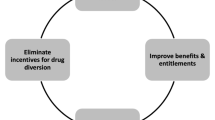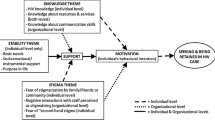Abstract
Competing needs pose barriers to engagement in HIV medical care. Mixed methods were used to explore and describe the needs of participants enrolled in Access to Care, a national HIV linkage, retention and re-engagement in care (LRC) program that served people living with HIV who knew their status but were not engaged in care. When asked to prioritize their most urgent needs, participants reported housing or shelter (31%), HIV medical services (24%), and employment (8%). When we assessed the HIV continuum of care by needs status, we found no significant differences in linkage, retention, or viral suppression between participants with and without basic needs. Qualitative interviews with program staff contextualized the barriers to HIV medical care faced by participants and explored the strategies used by LRC programs to address participant needs. Study findings will be of use to future programs and have implications for HIV policy, in particular the implementation of the National HIV/AIDS Strategy (2015–2020).
Similar content being viewed by others
References
Bradley H, Hall HI, Wolitski RJ, Van Handel MM, Stone AE, LaFlam M, et al. Vital signs: HIV diagnosis, care, and treatment among persons living with HIV—United States, 2011. MMWR Morb Mortal Wkly Rep. 2014;63(47):1113–7.
Bauman LJ, Braunstein S, Calderon Y, Chhabra R, Cutler B, Leider J, et al. Barriers and facilitators of linkage to HIV primary care in New York City. J Acquir Immune Defic Syndr. 2013;64(Suppl 1):S20–6.
Skarbinski J, Rosenberg E, Paz-Bailey G, Hall HI, Rose CE, Viall AH, et al. Human immunodeficiency virus transmission at each step of the care continuum in the United States. JAMA Intern Med. 2015;175(4):588–96.
Giordano TP, Gifford AL, White AC, Almazor MES, Rabeneck L, Hartman C, et al. Retention in care: a challenge to survival with HIV infection. Clin Infect Dis. 2007;44(11):1493–9.
White House Office of National AIDS Policy. National HIV/AIDS strategy for the United States. Washington, DC: The White House: July 13, 2010. http://www.whitehouse.gov/administration/eop/onap/nhas. Accessed February 27, 2016.
White House Office of National AIDS Policy. National HIV/AIDS Strategy for the United States: Updated to 2020. Washington, DC: The White House: July 2015. https://www.aids.gov/federal-resources/national-hiv-aids-strategy/nhas-update.pdf. Accessed February 27, 2016.
Kalichman SC, Hernandez D, Kegler C, Cherry C, Kalichman MO, Grebler T. Dimensions of poverty and health outcomes among people living with HIV infection: limited resources and competing needs. J Community Health. 2015;40(4):702–8.
Pellowski JA. Barriers to care for rural people living with HIV: a review of domestic research and health care models. J Assoc Nurses AIDS Care. 2013;24(5):422–37.
Higa DH, Marks G, Crepaz N, Liau A, Lyles CM. Interventions to improve retention in HIV primary care: a systematic review of US studies. Curr HIV/AIDS Rep. 2012;9(4):313–25.
Creswell JW, Klassen AC, Plano Clark VL, Smith KC. Best practices for mixed methods research in the health sciences. Bethesda: National Institutes of Health; 2011. p. 2094–103.
Health Resources and Services Administration. HIV/AIDS Bureau Performance Measures. http://hab.hrsa.gov/deliverhivaidscare/coremeasures.pdf.
Horberg MA, Aberg JA, Cheever LW, Renner P, Kaleba EOB, Asch SM. Development of national and multiagency HIV care quality measures. Clin Infect Dis. 2010;51(6):732–8.
Mugavero MJ, Westfall AO, Zinski A, Davila J, Drainoni ML, Gardner LI, et al. Measuring retention in HIV care: the elusive gold standard. J Acquir Immune Defic Syndr. 2012;61(5):574–80.
Renwick TJ, editor Budget-based poverty measurement: 1992 basic needs budgets. Proceedings of the American Statistical Association, Social Statistics Section; 1993.
Kim JJ, Maulsby C, Kinsky S, Riordan M, Charles V, Jain K, et al. The development and implementation of the national evaluation strategy of Access to Care, a multi-site linkage to care initiative in the United States. AIDS Educ Prev. 2014;26(5):429–44.
ATLAS.ti. Version 4.2. [Computer sofware] (1999) Berlin, Scientific Sofware Development.
Hsieh H-F, Shannon SE. Three approaches to qualitative content analysis. Qual Health Res. 2005;15(9):1277–88.
Rajabiun S, Cabral H, Tobias C, Relf M. Program design and evaluation strategies for the Special Projects of National Significance Outreach Initiative. AIDS Patient Care STDs. 2007;21(S1):S9–19.
Aidala AA, Wilson MG, Shubert V, Gogolishvili D, Globerman J, Rueda S, et al. Housing status, medical care, and health outcomes among people living with HIV/AIDS: a systematic review. Am J Public Health. 2016;106(1):e1–23.
Rumptz MH, Tobias C, Rajabiun S, Bradford J, Cabral H, Young R, et al. Factors associated with engaging socially marginalized HIV-positive persons in primary care. AIDS Patient Care STDs. 2007;21(S1):S30–9.
Enriquez M, Farnan R, Cheng A-L, Almeida A, Del Valle D, Pulido-Parra M, et al. Impact of a bilingual/bicultural care team on HIV-related health outcomes. J Assoc Nurses AIDS Care. 2008;19(4):295–301.
Gardner LI, Marks G, Craw JA, Wilson TE, Drainoni M-L, Moore RD, et al. A low-effort, clinic-wide intervention improves attendance for HIV primary care. Clin Infect Dis. 2012;55(8):1124–34.
Gardner LI, Giordano TP, Marks G, Wilson TE, Craw JA, Drainoni M-L, et al. Enhanced personal contact with HIV patients improves retention in primary care: a randomized trial in 6 US HIV clinics. Clin Infect Dis. 2014;59(5):725–34.
Jain KM, Maulsby C, Brantley M, team SIFi, Kim JJ, Zulliger R, et al. Cost and cost threshold analyses for 12 innovative US HIV linkage and retention in care programs. AIDS Care. 2016;28(9):1199–204.
Jain KM, Zulliger R, Maulsby C, Kim JJ, Team PCI, Charles V, et al. Cost-utility analysis of three U.S. HIV linkage and re-engagement in care programs from positive charge. AIDS Behav. 2016;20(5):973–6.
Acknowledgements
The authors would like to express their gratitude to the A2C intervention staff for their dedication and for the individuals who participated in the A2C intervention. We would like to thank Dr. Russell Brewer for his insightful contributions to the discussion section. This document is based upon work under Grant No. 10SIHDC001 and supported by the Social Innovation Fund (SIF), a program of the Corporation for National and Community Service (CNCS). Opinions or points of view expressed in this document are those of the authors and do not necessarily reflect the official position of, or a position that is endorsed by, CNCS or the Social Innovation Fund program. The Social Innovation Fund is a program of the Corporation for National and Community Service, a federal agency that engages millions of Americans in service through its AmeriCorps, Senior Corps, Social Innovation Fund, and Volunteer Generation Fund programs, and leads the President’s national call to service initiative, United We Serve. For more information, visit NationalService.gov. Opinions or points of view expressed in this document are those of the authors and do not necessarily reflect the official position of, or a position that is endorsed by, the Corporation or the Social Innovation Fund, AIDS United, Johns Hopkins Bloomberg School of Public Health, or the grantees of the A2C initiative. We would also like to acknowledge those whose who took time to review the manuscript and thank Dr. Ronald Valdiserri for his invaluable contributions.
Funding
This study was funded by AIDS United in partnership with the Social Innovations Fund, a program of the Corporation for National and Community Service (CNCS) Fund (Grant No. 10SIHDC001).
Author information
Authors and Affiliations
Consortia
Corresponding author
Ethics declarations
Conflict of interest
Catherine Maulsby, Blessing Enobun, D. Scott Batey, Kriti Jain, The Access to Care Intervention Team, Maura Riordan, Melissa Werner, and David Holtgrave have no conflicts of interest to disclose.
Ethical Approval
All procedures performed in studies involving human participants were in accordance with the ethical standards of the institutional and/or national research committee and with the 1964 Helsinki declaration and its later amendments or comparable ethical standards.
Informed Consent
Program sites underwent IRB approval locally. Program evaluation activities implemented by ActionWellness (Chesapeake IRB) and The Damien Center (IntegReview) were found to be non-human subjects research and to not require IRB oversight. Program evaluation activities conducted by the University of Alabama at Birmingham (University of Alabama) and Louisiana Public Health Institute (Ethical and Independent Review Services) were found to be human subjects research and informed consent was obtained from participants. JHU’s IRB found the qualitative portion of this study to be non-human subjects research and informed consent was not obtained for individuals interviewed about organizational-level programmatic activities.
Additional information
The members of the A2C Evaluation Intervention Team: Elizabeth Hagan, Cody Poerio, Dorsche Pinsky, Odessa Summers (Action Wellness, Philadelphia, PA) Michael Hassler (COMHAR, Philadelphia, PA), Dagmar Mitchell (Together House and Gaudenzia, Philadelphia, PA), Hal Shanis, (Shanis Analysis, Philadelphia, PA) James Peightel (Pathways to Housing, Philadelphia, PA); Sarah Chrestman and Russell Brewer (Louisiana Public Health Institute, New Orleans, LA); David Fine, Charles Shumate, and Sara Salomon (CARDEA Services, Seattle, WA), Abbe Shapiro (The Damien Center, Indianapolis, IA); D. Scott Batey (University of Alabama at Birmingham, Birmingham, AL).
Rights and permissions
About this article
Cite this article
Maulsby, C., Enobun, B., Batey, D.S. et al. A Mixed-Methods Exploration of the Needs of People Living with HIV (PLWH) Enrolled in Access to Care, a National HIV Linkage, Retention and Re-Engagement in Medical Care Program. AIDS Behav 22, 819–828 (2018). https://doi.org/10.1007/s10461-017-1809-3
Published:
Issue Date:
DOI: https://doi.org/10.1007/s10461-017-1809-3




